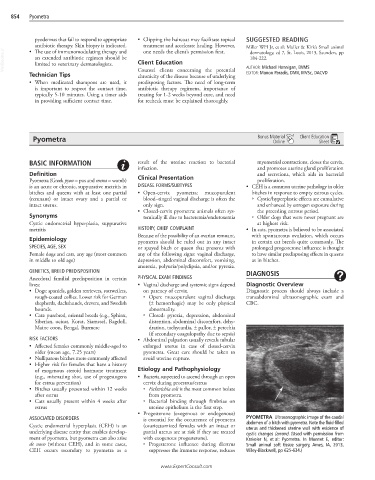Page 1697 - Cote clinical veterinary advisor dogs and cats 4th
P. 1697
854 Pyometra
pyodermas that fail to respond to appropriate • Clipping the haircoat may facilitate topical SUGGESTED READING
antibiotic therapy. Skin biopsy is indicated. treatment and accelerate healing. However, Miller WH Jr, et al: Muller & Kirk’s Small animal
VetBooks.ir an extended antibiotic regimen should be Client Education AUTHOR: Michael Hannigan, BVMS
• The use of immunomodulating therapy and
one needs the client’s permission first.
dermatology, ed 7, St. Louis, 2013, Saunders, pp
184-222.
limited to veterinary dermatologists.
Technician Tips Counsel clients concerning the potential EDITOR: Manon Paradis, DMV, MVSc, DACVD
chronicity of the disease because of underlying
• When medicated shampoos are used, it predisposing factors. The need of long-term
is important to respect the contact time, antibiotic therapy regimens, importance of
typically 5-10 minutes. Using a timer aids treating for 1-2 weeks beyond cure, and need
in providing sufficient contact time. for recheck must be explained thoroughly.
Pyometra Bonus Material Client Education
Sheet
Online
BASIC INFORMATION result of the uterine reaction to bacterial myometrial contractions, closes the cervix,
infection. and promotes uterine gland proliferation
Definition and secretions, which aids in bacterial
Pyometra (Greek pyon = pus and metra = womb) Clinical Presentation proliferation.
is an acute or chronic, suppurative metritis in DISEASE FORMS/SUBTYPES • CEH is a common uterine pathology in older
bitches and queens with at least one partial • Open-cervix pyometra: mucopurulent bitches in response to empty estrous cycles.
(remnant) or intact ovary and a partial or blood–tinged vaginal discharge is often the ○ Cystic/hyperplastic effects are cumulative
intact uterus. only sign. and enhanced by estrogen exposure during
• Closed-cervix pyometra: animals often sys- the preceding estrous period.
Synonyms temically ill due to bacteremia/endotoxemia ○ Older dogs that were never pregnant are
Cystic endometrial hyperplasia, suppurative at highest risk.
metritis HISTORY, CHIEF COMPLAINT • In cats, pyometra is believed to be associated
Because of the possibility of an ovarian remnant, with spontaneous ovulation, which occurs
Epidemiology pyometra should be ruled out in any intact in certain cat breeds quite commonly. The
SPECIES, AGE, SEX or spayed bitch or queen that presents with prolonged progesterone influence is thought
Female dogs and cats, any age (most common any of the following signs: vaginal discharge, to have similar predisposing effects in queens
in middle to old age) depression, abdominal discomfort, vomiting, as in bitches.
anorexia, polyuria/polydipsia, and/or pyrexia.
GENETICS, BREED PREDISPOSITION DIAGNOSIS
Anecdotal familial predisposition in certain PHYSICAL EXAM FINDINGS
lines: • Vaginal discharge and systemic signs depend Diagnostic Overview
• Dogs: spaniels, golden retrievers, rottweilers, on patency of cervix. Diagnostic process should always include a
rough-coated collies. Lower risk for German ○ Open: mucopurulent vaginal discharge transabdominal ultrasonographic exam and
shepherds, dachshunds, drevers, and Swedish (± hemorrhagic) may be only physical CBC.
hounds. abnormality.
• Cats: purebred, oriental breeds (e.g., Sphinx, ○ Closed: pyrexia, depression, abdominal
Siberian, ocicat, Korat, Siamese), Ragdoll, distention, abdominal discomfort, dehy-
Maine coon, Bengal, Burmese dration, tachycardia, ± pallor, ± petechia
(if secondary coagulopathy due to sepsis)
RISK FACTORS • Abdominal palpation usually reveals tubular
• Affected females commonly middle-aged to enlarged uterus in case of closed-cervix
older (mean age, 7.25 years) pyometra. Great care should be taken to
• Nulliparous bitches more commonly affected avoid uterine rupture.
• Higher risk for females that have a history
of exogenous steroid hormone treatment Etiology and Pathophysiology
(e.g., mismating shot, use of progestogens • Bacteria suspected to ascend through an open
for estrus prevention) cervix during proestrus/estrus
• Bitches usually presented within 12 weeks ○ Escherichia coli is the most common isolate
after estrus from pyometra.
• Cats usually present within 4 weeks after ○ Bacterial binding through fimbriae on
estrus uterine epithelium is the first step.
• Progesterone (exogenous or endogenous)
ASSOCIATED DISORDERS is essential for the occurrence of pyometra PYOMETRA Ultrasonographic image of the caudal
Cystic endometrial hyperplasia (CEH) is an (ovariectomized females with an intact or abdomen of a bitch with pyometra. Note the fluid-filled
uterus and thickened uterine wall with evidence of
underlying disease entity that enables develop- partial uterus are at risk if they are treated cystic changes (arrow). (Used with permission from
ment of pyometra, but pyometra can also arise with exogenous progesterone). Krekeler N, et al: Pyometra. In Monnet E, editor:
de novo (without CEH), and in some cases, ○ Progesterone influence during diestrus Small animal soft tissue surgery, Ames, IA, 2013,
CEH occurs secondary to pyometra as a suppresses the immune response, reduces Wiley-Blackwell, pp 625-634.)
www.ExpertConsult.com

